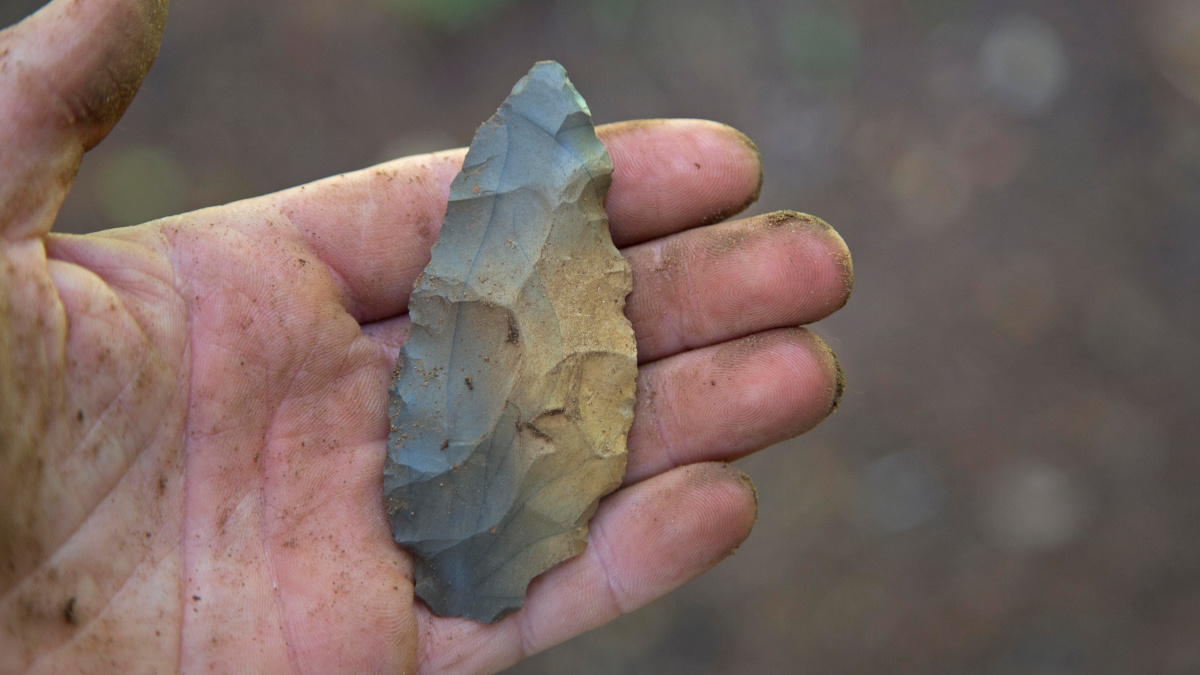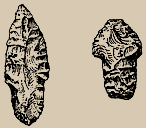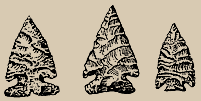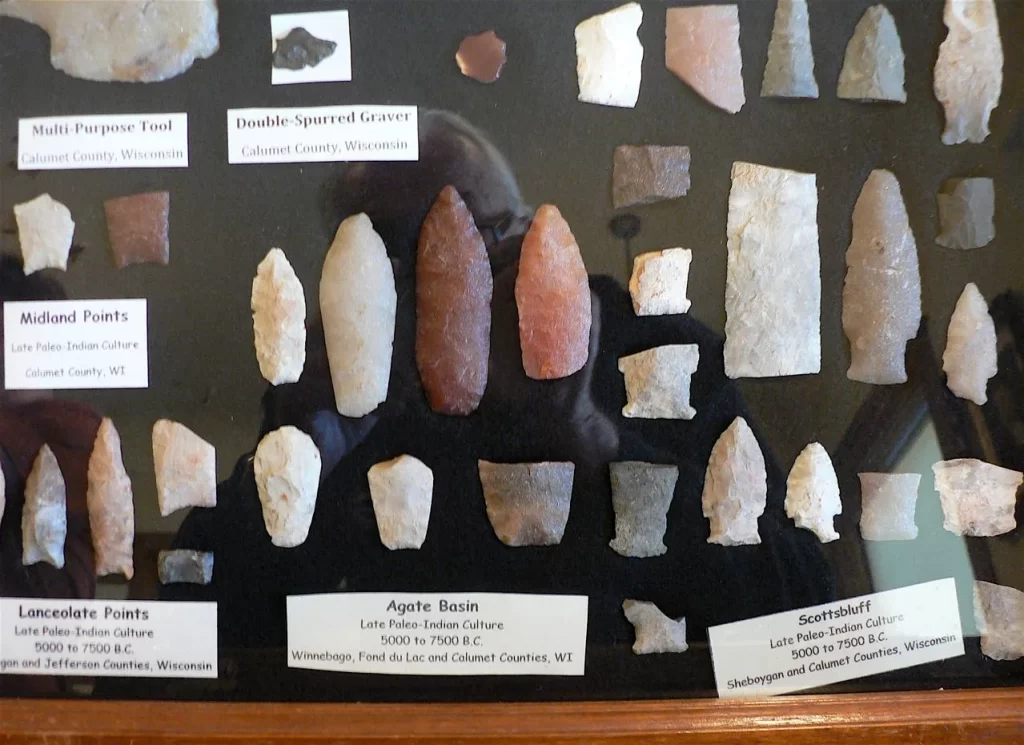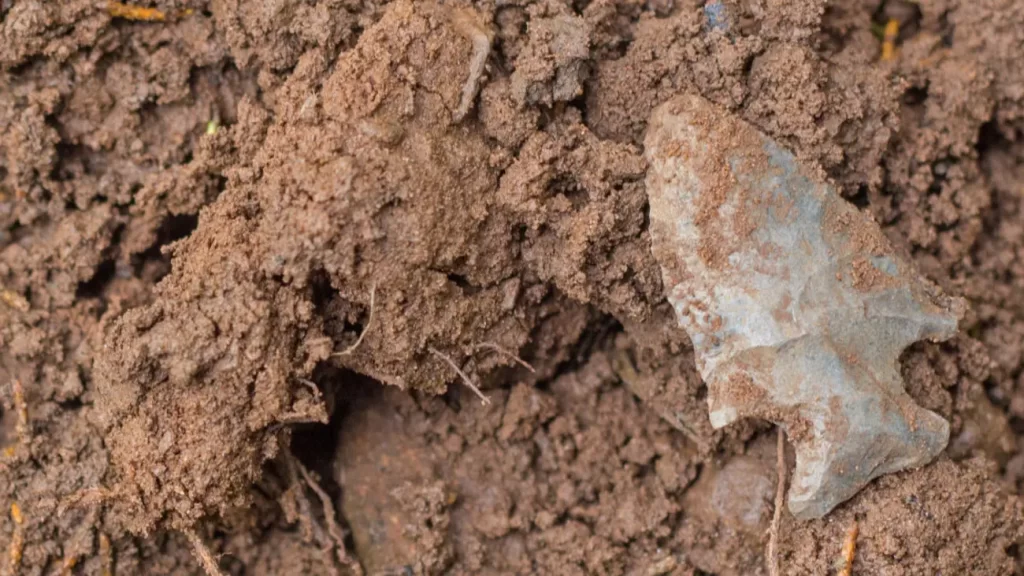Native American Indian Arrowheads in California
Projectile Points and Weapon Tips
What’s The Difference?
Can you believe it? The shape of an arrowhead (scientists call them projectile points because not all of them were used on arrows) and what it is made of give many clues about how people lived thousands of years ago.
The place where you find an arrowhead and the rocks and dirt around it are also very important. They tell us how long ago the arrowhead was made and used. It’s a good idea to leave arrowheads and other objects made by ancient peoples where you find them. Contact a teacher or the museum so they can be studied more carefully.
Clovis point 13,000 to 10,000 years ago Big animals like mammoths and camels.
|
||||
Lake Mojave point 10,000 to 8,000 years ago Small, fast species like antelope and rabbits.
|
||||
Pinto point 10,000 to 6,000 years ago Small mammals and ducks.
|
||||
Elko point 4,000 to 1,500 years ago Small mammals and ducks.
|
||||
Rose Springs point – 1,500 to 900 years ago Deer and small mammals.
|
||||
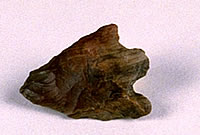 |
Rose Springs points are the first actual arrowheads in this group. Bow and arrow technology was adapted by the Native Americans in the Mojave desert around 1,500 years ago. |
Cottonwood and Desert Side Notched points – 900 to 150 years ago
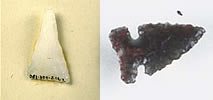 |
These two styles of projectile point were used in the Great Basin and the Antelope Valley into the nineteenth cen |
Best Websites For Indian Arrowhead Identification
There are a lot of websites available for helping you identify arrowheads as well as determining an arrowheads value, but I’ve compiled a few of the best resources. Using these sites together in researching your arrowhead will work best. One website may be able to help you narrow down your search, while another might help you really hone in on what type of arrowhead you have.
Things to consider when identifying Native American Indian arrowheads
Location
Where you found your arrowhead will play a very critical role in starting to identify it. As I mentioned earlier, when you go to projectilepoints.net, you can go directly to the state where you found the arrowhead. This will eliminate hundreds of other arrowheads that may look similar as yours.
Shape
Note the shape of the arrowhead. Is it stemmed or stemless? If it’s stemmed, does the stem contract or expand? Or is the stem straight? You also want to pay attention to the notching on the arrowhead. Are the notches on the side, the corner or the base?
1. Projectilepoints.net
Projectilepoints.net is my favorite website for arrowhead identification. You can perform a visual search based on multiple pictures of arrowheads, or you can do a regional search. But the best feature that this website offers is the “search by state” option. This really helps in quickly narrowing down your search.
The information you can find on this site includes the name of the arrowhead, a picture (or pictures) of the arrowhead, a description of its shape and its size as well as the cultural period the arrowhead came from. This is excellent information for diving into the history and the background of your arrowheads.
2. Typology.arrowheads.com
Typology.arrowheads.com is another great resource for arrowhead identification. It offers the same search features as Projectilepoints.net except it doesn’t give the option for searching by state, which for me has been the most powerful and useful search option. source
6 PLACES TO FIND NATIVE AMERICAN ARROWHEADS
he last human to touch this before us was planning to cook dinner over an open fire using a critter killed with this,” I told my kids.
With eyes aglow, they fondled the stone point like it was pure gold. We’d just found evidence of ancient hunters in our front yard, but there was a time when finding an arrowhead was a matter of sheer luck for me. Every couple of years a random gaze toward the dirt would produce a point. But now I have a strategy when afield.
Here are six places where you can find ancient tools. But before you start looking for projectile points, it’s important to understand legalities. Most public lands don’t allow the removal of artifacts, so brush up on federal and state regulations before starting your search.
Prominent Creeks The first humans arrived in North America at least 15,000 years ago and dispersed across the continent. Without methods to store and transport water, they needed daily access to fresh water. So, they camped, traveled, and hunted near water systems. In these drainages they also made, left, lost, and broke stone tools. These points washed into creeks or rivers and become part of their gravel system over the centuries.
Walk creeks and look for unnatural colored rocks and shapes. In some cases, natives used non-local stone like obsidian, which makes the points stand out. Flowing water sifts gravel into different sizes along gravel bars. Look for points in gravel bars where rocks are similar in size to the points you’re hoping to find. Keep your eye on the outside bend (or cut bank side) of the creek where erosion exposes bare dirt.
High Spots Near Water In my front yard there is a small rise, probably not more than 18 inches higher than the surrounding ground. On two sides of the rise are small creeks. I’ve found more stone points and flint flakes there than any other place on my property. It’s likely this was a historical campsite.
I’ve heard it said, “good land now was good land then.” When traveling water systems, look for high points that would have given campers good visibility, a flat surface, and protection from high water. If you’d like to camp there, then our ancestors probably did, too. These high spots could be large or small, but the principles are the same.
Springs Fresh drinking water located away from larger water systems also makes for quality camping. These early peoples tent-camped or slept under the stars 365 days a year and understood the advantages that made life easier. Here’s a tip: If you find flint flakes (chips) in an area, stone points are close. These hunters were constantly knapping out stone points or sharpening the ones they already had.
Percussion knapping leaves a lot of chips. Where you find them, you’re bound to find full points. Ask yourself this: where would make for quality camping and living near springs. Your gut might be right—look there.
Exposed Dirt More points have probably been in found in plowed fields than any other place. Modern agriculture is often located in ideal locations for ancient camping and hunting. Exposed dirt is key to finding points, and a fresh rain can make points easy to spot.
Often they’re perched above the surface of the ground on a soil platform and appear to almost glow. It’s an incredible sight! Any place with exposed, bare dirt has a possibility of revealing points. I started finding heads on my land when our mules made trails and dirt wallows. Look in cattle trails, places where machinery has skinned the ground, dirt roads, eroded bluffs and banks, and even buck scrapes.
Rock Overhangs Natives were smart campers and took advantage of terrain features for shelter, including rock ledges and caves. These places hold stone points. If a couple of people could huddle underneath it to stay dry, they likely did, and they probably left something there.
Many serious artifact hunters dig out rock overhangs (on private land, where legal) and even run the dirt through a screen. Organic matter builds up over centuries under these features and points can be many feet below the surface. Look for ledges that have flint flakes nearby or smoke-stained ceilings.
Flea Markets Ancient tools made by prehistoric hunters are cool no matter how you come across them. Keep your eyes peeled for stone points at flea markets, garage sales, or from individuals who may not value them. I never thought I would enjoy owning a purchased point, but I’m beginning to rethink that position.
Much of the value of my personal collection is attributed to the fact that I found them. However, when you recognize the art and skill of these ancient flint knappers, you can still appreciate a point that someone else found.
But, hopefully the first five spots produce so you don’t need to rely on second-hand arrowheads. Keep your eyes on the ground when afield and you just might find something incredible. Clay Newcomb source
Finding An Arrowhead Is Just The Beginning
For many of people that enjoy hunting arrowheads, finding the arrowhead alone is reward in itself. For the rest of us, however, there is are many more questions we want answered. Typical questions we have are:
-
What type of arrowhead is this?
-
When was this arrowhead made?
-
Who made this arrowhead and what was the culture like?
-
Is this an authentic American Indian arrowhead?
-
And perhaps we may even want to know, what’s the arrowheads value?
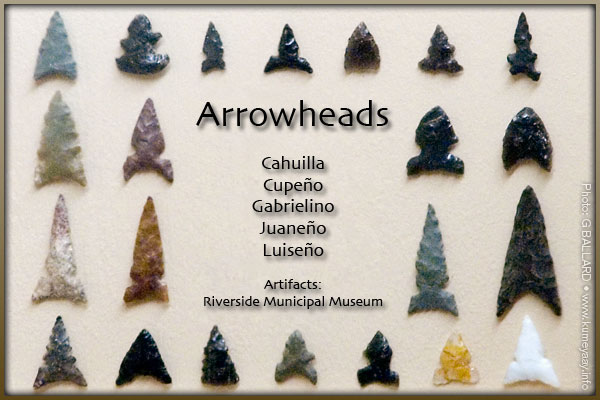
OLD CALIFORNIA INDIAN ARROWHEADS
These authentic old California Indian arrowheads photos are as pictured (photographed through the display glass) in the RIVERSIDE MUNICIPAL MUSEUM in Riverside California.
These genuine arrowhead artifacts of the southwestern USA aboriginal Native American Indians of North America include ancient relics specimens from the tribes of Cahuilla, Cupeño Cupeno, Gabrielino, Juaneño Juaneno, Luiseño Luiseno Indigenous peoples of Southern California and northern Baja California Mexico.
The California Indian aborigines typically handcrafted their stone hunting and war arrowheads from obsidian, chert, jasper…
Native American California Indian arrowheads artifacts contributed by the RIVERSIDE MUNICIPAL MUSEUM, Riverside, CA.
CALIFORNIA INDIAN BOWS & ARROWS features deep field and museum research, photography and captions as published in SURVIVAL SKILLS OF NATIVE CALIFORNIA, by Paul D. Campbell. Paul’s book features living Native American California Indigenous people of the greater San Diego area, and details their traditional hunting, weapons and aboriginal California Indian survival methods. source
12,000 years ago
Sampson began by explaining that stone projectiles (spears) and tools in Wisconsin go back 12,000 to 13,000 years to what is called the Early Paleo-Indian era. Glaciers were receding, wandering bands of people were settling in the area. They hunted bison and mastodon with spear-shaped projectile points and used stone choppers and scrappers to process game and dress hides.
Over the years the climate became warmer and the way of life of the population changed. Sometime in the 1,000 to 3,000 BC era, the use of a spear thrower (atlatl) was developed. This new piece of equipment equipped with a long wooden shaft enabled the spear thrower to increase the force and throwing range of spears in hunting.
Bow and arrow is a late arrival
Although I, and probably most people, refer to the artifacts we find or have inherited as arrows, many are really spears. Sampson explains that the bow and arrow were a relatively late addition to the prehistoric record and didn’t come into existence until 400 to 500 A.D.
Nowadays it is possible to determine with fair accuracy where the artifact came from and how old it is.
How old?
It wasn’t until the 1950s, when radiocarbon dating became practical, that it became possible to date projectile points and enable archeologists to determine when certain arrowheads were in fashion. The stone material used can determine where the material originated. Note: There are about 30 rock types in Wisconsin that Native Americans used to make tools and projectiles, many that have provided raw material for many thousands of years. source

